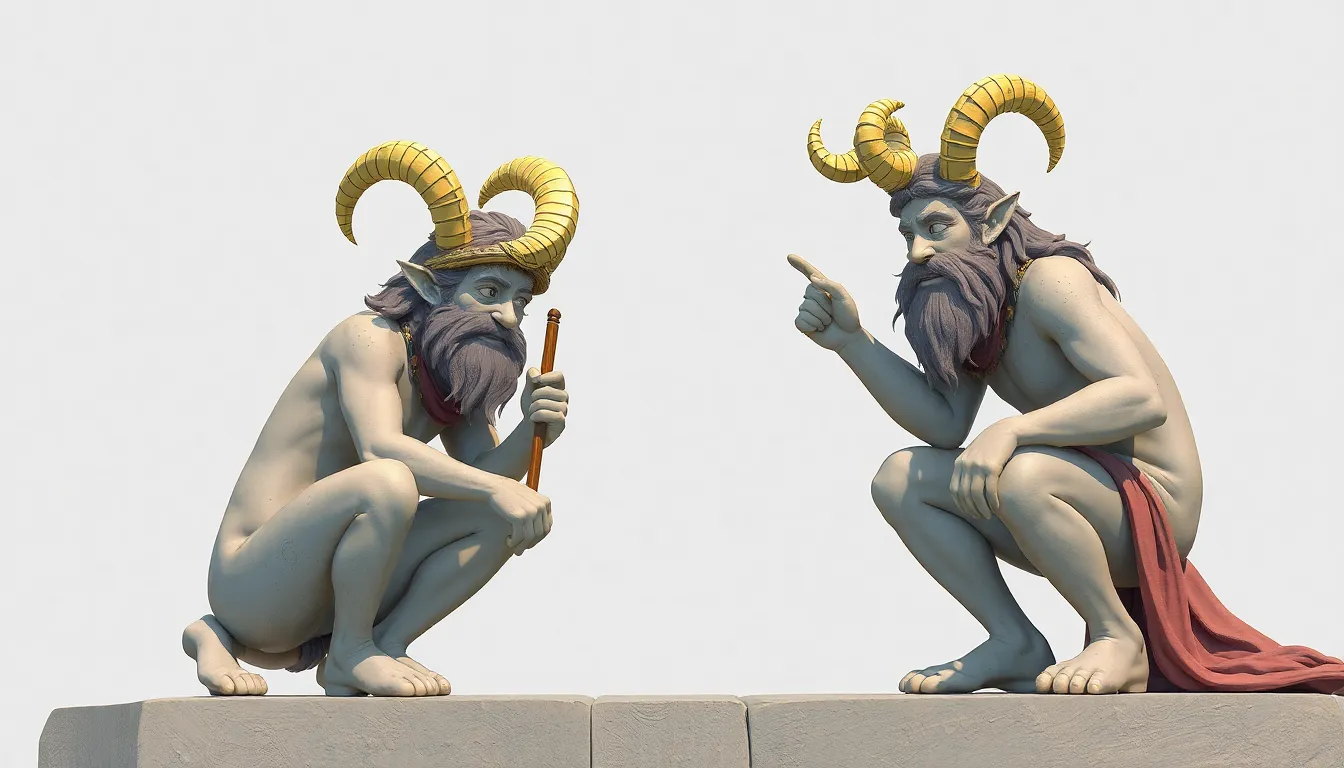Satyrs in Children’s Literature: Teaching Values Through Myth
I. Introduction
In the rich tapestry of Greek mythology, satyrs are often depicted as half-man, half-goat creatures, known for their playful and mischievous nature. These beings are closely associated with Dionysus, the god of wine, fertility, and revelry, embodying the spirit of nature and the untamed wilderness. The role of mythological creatures like satyrs extends beyond mere entertainment; they serve as powerful symbols in children’s literature, imparting moral lessons and values to young readers.
This article aims to explore how satyrs convey essential values through their stories, emphasizing their historical significance, symbolic meanings, and the moral lessons embedded in their characterizations.
II. Historical Context of Satyrs in Mythology
Satyrs have their origins in ancient Greek mythology, where they were often portrayed as companions of Dionysus, indulging in music, dance, and revelry. Their origins can be traced back to earlier fertility deities and nature spirits, evolving over time into the more recognizable figures we see in classical literature.
The satyr archetype has undergone significant evolution through centuries:
- Ancient Art and Literature: Satyrs appear in various ancient texts, including works by Homer and Hesiod, often symbolizing the joy of life and the pleasures of nature.
- Renaissance and Beyond: During the Renaissance, satyrs were reimagined in art and literature, reflecting the humanist ideals of the time, often depicted in pastoral scenes.
- Folklore Across Cultures: Similar creatures exist in various cultures—like the Pan in Roman mythology—illustrating the universal appeal of nature spirits.
III. Satyrs as Symbols of Nature and Freedom
Satyrs are intrinsically linked to the natural world, embodying the essence of rural life and the wild beauty of untamed forests. They represent a connection to nature that is often lost in modern society.
Furthermore, satyrs illustrate the theme of freedom versus societal constraints:
- Embrace of Nature: Satyrs celebrate the joys of nature, encouraging children to appreciate the world around them.
- Spirit of Freedom: Their carefree nature serves as a reminder of the importance of freedom and the joy of living outside societal norms.
Through these themes, satyrs teach young readers valuable lessons about the importance of environmental appreciation and the need for play and creativity in their lives.
IV. Satyrs and the Exploration of Human Emotions
Satyrs are often portrayed as embodiments of joy, mischief, and folly. Their antics can be both humorous and thought-provoking, providing an engaging way for children to explore a wide range of human emotions.
The satyr’s role in literature serves to teach children about:
- Joy and Laughter: Their playful nature encourages children to find happiness in simple pleasures.
- Mischief and Learning: The mischief of satyrs often leads to important lessons, illustrating the consequences of one’s actions.
Notable children’s books featuring satyrs, such as The Chronicles of Narnia by C.S. Lewis, showcase these themes, helping children navigate and understand their emotions through relatable characters.
V. Moral Lessons Embedded in Satyr Characters
Satyr characters often face moral dilemmas, providing fertile ground for discussing ethics with children. Through their stories, young readers are exposed to themes of friendship, loyalty, and the consequences of one’s actions.
Some key moral lessons include:
- Friendship: The camaraderie among satyrs teaches the importance of loyalty and support in relationships.
- Consequences of Actions: Misadventures often lead to lessons about responsibility and the impact of choices.
These narratives can facilitate discussions about ethical decision-making, enabling children to reflect on their values and actions.
VI. Satyrs in Contemporary Children’s Literature
In modern adaptations, satyrs continue to capture the imagination of young readers. Authors have reinterpreted these creatures in various ways, making them relevant to contemporary themes and issues.
Prominent authors and their works featuring satyrs include:
- Rick Riordan: In the Percy Jackson series, the character Grover Underwood, a satyr, embodies themes of friendship, loyalty, and environmentalism.
- George R.R. Martin: In the A Song of Ice and Fire series, satyr-like characters reflect the complex interplay of morality and nature.
The relevance of satyrs in today’s cultural and educational context highlights the enduring legacy of these mythological figures in teaching lessons about humanity, nature, and ethics.
VII. The Impact of Satyrs on Childhood Development
Engaging with mythological narratives featuring satyrs can have profound psychological benefits for children. These stories foster the development of critical thinking and empathy, as children learn to navigate complex characters and situations.
Through satyr stories, children can:
- Enhance Empathy: Understanding the motivations and emotions of satyrs helps children relate to others.
- Encourage Creativity: The fantastical elements of satyr tales stimulate imagination and encourage creative expression.
These developmental benefits make satyr narratives valuable tools in both educational settings and home environments.
VIII. Conclusion
In conclusion, satyrs serve as significant figures in children’s literature, imparting essential values and lessons that resonate with young readers. Their representation of nature, freedom, and the exploration of human emotions enriches children’s understanding of the world around them.
The lasting impact of these mythological figures underscores the importance of incorporating satyr-themed stories into educational and parenting practices. By encouraging children to engage with these narratives, we can foster a deeper appreciation for the values they embody.
Parents and educators are urged to explore the enchanting world of satyrs with children, opening up discussions about ethics, emotions, and the joys of nature. In doing so, we not only preserve the legacy of these mythological creatures but also enrich the lives of young readers.




